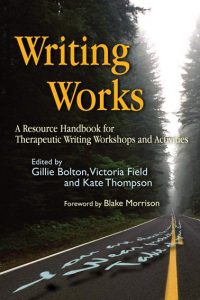A Resource Handbook for Therapeutic Writing Workshops and Activities
Gillie Bolton, Victoria Field and Kate Thompson (eds)
Jessica Kingsley Publishers
2007
Creative writing is a powerfully therapeutic for personal development: recognised in the growing numbers of workshops and writing groups within professional contexts, including clinical, health and criminal justice settings. Writing Works is a guide for writers or therapists working with groups or individuals and is full of practical advice on everything from the equipment needed to run a session to ideas for themes, all backed up by the theory that underpins the methods explained. Experienced practitioners in the field contribute detailed illuminating accounts of organising writing workshops for a wide range of different clients, together with examples of their outcomes.
This book is an invaluable start-up reference for arts therapists and professionals working across the health, social care and caring professions, and one that will be referred to again and again.
Foreword by Blake Morrison
‘One sheds one’s sicknesses in books’, D. H. Lawrence wrote after completing Sons and Lovers, ‘repeats and presents again one’s emotions, to be master of them’. Ted Hughes said something similar shortly before he published the Birthday Letters, a book of elegies to his late wife, Sylvia Plath: ‘What’s writing really about? It’s trying to take fuller possession of the reality of your life – to attack it and attack it and get it under control’. This idea of writing as a way of controlling or mastering one’s emotions has sometimes been frowned upon; surely writing ought to be more than therapy, people say. Well, yes, but the process of articulating painful truths can be restorative, healing, even life-saving. And there’s no reason why writing produced at moments of crisis or distress can’t be good writing, especially if the writer has some guidelines to work with – or a midwife at hand to assist with the birth.
This handbook is written in that spirit, not just to give vague encouragement to would-be writers but as a practical how-to book, with warm-up exercises, tips on how to form and convene writing groups, descriptions of the responsibilities and difficulties involved and countless examples from the pioneering work which the three authors and others have done in this field. There are also personal testimonies from those who have benefited from attending workshops, including, for example, Jane Tozer, who recounts how writing poetry in a little-known verse-form, the ghazal, restored her confidence and ‘connected me with intensely personal subject-matter’.
The term ‘bibliotherapy’ has entered the language only recently. But the link between literature and healing goes back to Aristotle and his notion of catharsis (or ‘purgation’). Shakespeare, too, understood the importance of self-expression: ‘Give sorrow words’, he wrote, ‘the grief that does not speak/Whispers the o’er fraught heart, and bids it break’.
Giving sorrow words needn’t mean pouring things out in a torrent; even confessions have to be shaped. Some poets prefer free verse, but many are liberated by working within a given form or of regular rhythmic pattern. Some prose writers are candidly autobiographical, while others boldly invent. There are no hard and fast rules and this book doesn’t attempt to legislate. But the exercises it describes – with alphabet poems, acrostics, stories, sonnets, pantoums, fairytales and visualisations – are immensely useful, and whatever your interest in writing,whether you’re a counsellor, a teacher or a student, you will find yourself wanting to try them out.
This is a book that deserves a place not just in schools and colleges but in hospitals, prisons, rehab clinics and community centres. Anyone who cares about writing will find it rewarding. And anyone professionally concerned with the health – and mental health – of this country should be made to read it. ‘One sheds one’s sicknesses in books’, as Lawrence said, and this book is part of the cure.
Blake Morrison, poet, novelist and critic
Writing Works: Launch Speech: Professor Cecil Helman
University College Medical School, London University
I am privileged to introduce Writing Works, edited by Gillie Bolton, Victoria Field and Kate Thompson.
The book is about the why and the how of therapeutic writing. It is edited by three of the leading practitioners of the craft in the UK, with contributions by many others involved in the process therapeutic writing.
It is a rich feast – with many different dishes in it. To give a brief glimpse of the menu of this feast, it includes:
- Practical tips on how to actually start and run a therapeutic writing workshop
- Specific advice on forming a therapeutic-relationship with a client or patient
- Examples of poetry and prose produced by therapeutic-writing workshops
- Case-histories of individuals, and groups
- Accounts of actual workshops run by many different facilitators, both in the UK, the USA and elsewhere
- Personal narratives by those involved in the process, many of them both moving and inspiring
- Self-reflection of those involved in the process, illustrating that therapeutic writing involves not only the inner world of the client, but also that of the listeners themselves.
But why writing? Why stories?
As Gillie has written, in the Introduction to the book: ‘Writing offers a powerful avenue towards finding out what one think, feels, knows, understands, remembers. It can enable fruitful and open exploration of potential thoughts and ideas.’
In other words, writing – or telling – one’s story can also be therapeutic, and it is especially important in dealing with the ill and the dying, the depressed and the despairing.
But I would also say that it is also useful (and often therapeutic) not only to the storyteller themselves, but also to the listener, often at an unconscious level. I think it was Henry Miller who said that the sign of a good storyteller is that the listener becomes lost in their own reveries, long before the story itself is finished. In therapeutic writing, therefore, the inner story of the teller, and the inner story of the listener, often weave together into a new gestalt – meaningful for both parties involved in the process.
Stories of suffering or sickness are a special genre of tales. Howard Brody has pointed out that telling such stories is a basic human way of organizing an experience, especially a traumatic experience, especially those that involve illness. It is a way of ‘making sense of it’, and of giving it a meaning. Story-telling is thus a fundamental human way of dealing with misfortune, and of imposing order onto chaos.
But as described in this book, the writing and the stories told are quite unique, for unlike the usual ‘literary’ stories, they are un-contaminated by the malign influence of the marketplace, by the allure of fame or money or literary prizes, or the pressures of agents and publishers, or the need to ‘publish or perish’. They are small private stories, told in small private encounters between two or more people. They are a ‘pure’ form of literature, and as such they remind me, as an anthropologist, of the oral tales, myths and legends told – and re-told – by people living in pre-industrial societies.
An image comes to mind here:-
Back in my native South Africa, the San people (formerly known as the Bushmen) have a rich oral tradition, one that has lasted for millennia. For much of that time, their traditional stories and myths have been told, and re-told, around their crackling campfires, their sparks rising up to join the huge canopy of stars in the dense African night. These stories were usually about great hunts or great heroes, but also about mythical animals and man-animals. Stories told while in the deep shadows of the veldt around them, they could hear the rustle and roar of unseen creatures.
For the San, apparently, stories had an existence separate from that of their storyteller. They were believed to inhabit the physical landscape around them. They were everywhere. Stories floated around on the wind. They passed through mountains and travelled across the veldt, carrying the story from one story-teller to the next. The stories drifted especially to those who were alert to them, and could take them in – and then tell them to the rest of the tribe, before they moved on to the next teller. As one San elder in the 1870s put it: ‘I listen, watching for a story, which I want to hear… I sit waiting for it; that it may float into my ear.’ ‘I feel a story is the wind’, he said.
In this setting, each re-telling of a mythic story was unique. It was a performance tailored to a particular audience, at a particular time and place. The story told was always the same, but at the same time it was always very different. And the same, I think, applies to therapeutic writing: to private mythologies and legends, as well as to individual stories of bereavement, cancer or other afflictions.
I would say that Gillie Bolton, Victoria Field, Kate Thompson – and the other contributors – are catchers of these poignant human stories as they drift past them, in hospices and hospital wards and clinics, in self-help groups or in writing workshops. By gently encouraging those stories to emerge and be written, and then listening to them in a particularly focused and compassionate way, they are turning a genre of personal expression into a type of healing.
So the book both illustrates – and confirms – that writing does work – and for that reason I heartily recommend it to you all.
Dr Cecil Helman
April 2007
Buy here
ISBN 10: 1 84310 468 7; ISBN 13: 9781843104681


